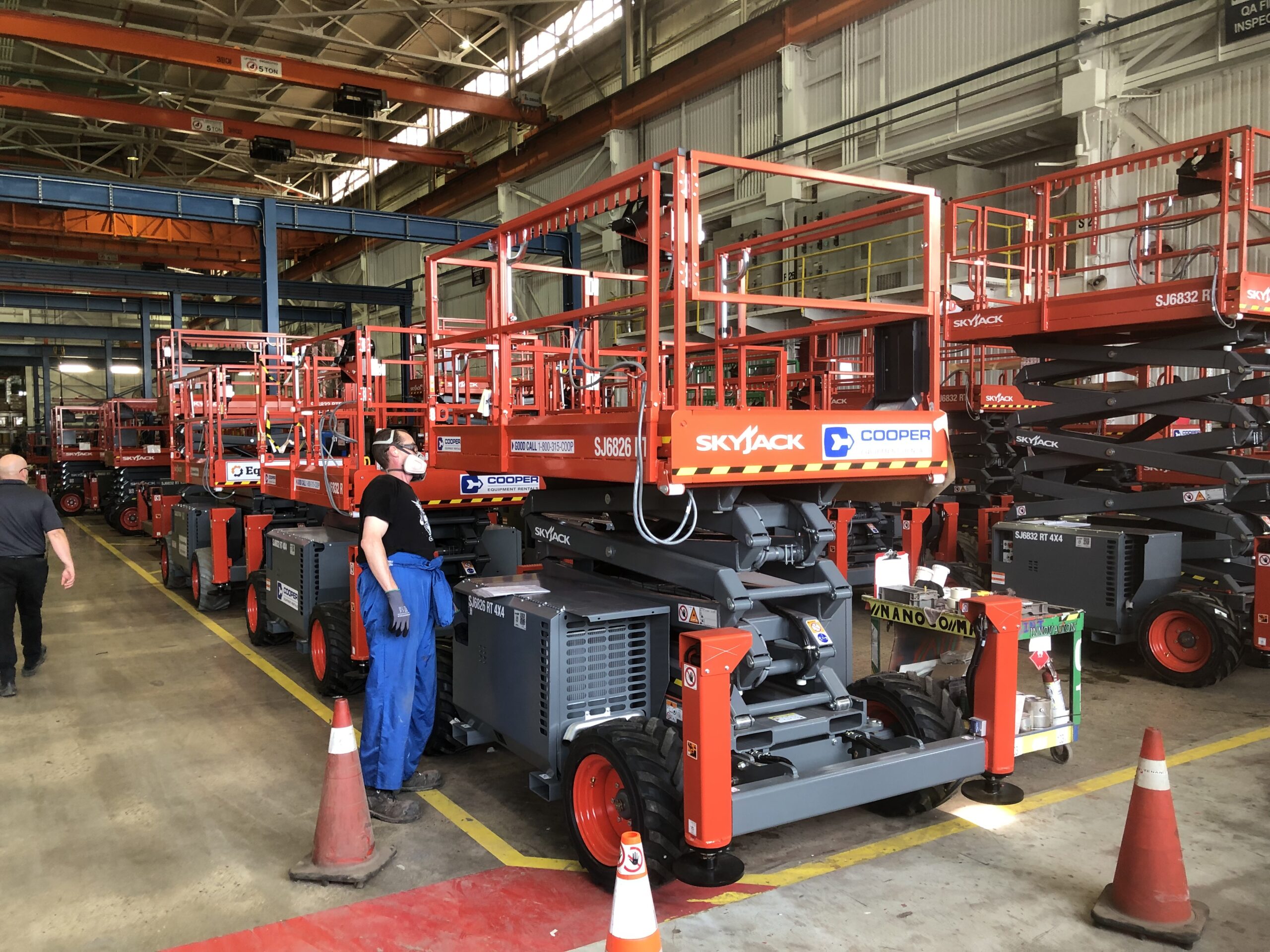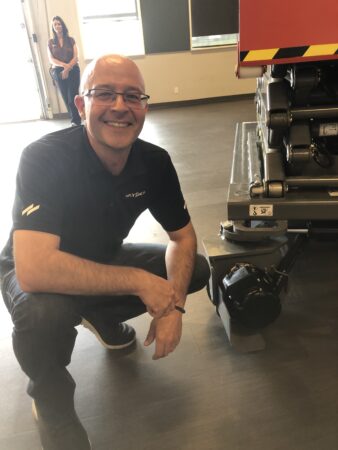
Connolly and Bazzarella on Skyjack’s design philosophy
Patrick Flannery
Features Supplier stories Tech tips

Corey Connolly
Canadian Rental Service sat down with Skyjack’s Corey Connolly, senior product manager, and Raphael Bazzarella, Latin America territory manager, at their Guelph, Ont., plant to talk about their approach to lift design and the challenges of introducing new products into a global market.
CRS: You guys have your your AC drive and scissors coming out. The great thing that I’m learning here is that there’s a very different idea about product design when you come from a lift engineering background, like some of our friends here in the international media do, versus when you come from the rental industry. I think rental people want possibly a different approach from you guys, from how you approach change, and how you approach introducing new technology.
CC: Well, I would say we definitely want to be working with our customers and partnering with them when it comes to new product development, whether it be completely new products, new models, new features, or just what new features would be like when updating our current product. Instead of trying to dictate what we’re going to provide them.
CRS: Do you ever see that that look of fear in their eyes when you talk about doing something really new and radical?
CC: Not very often. Maybe initially, but a lot of times that’s because we’re preemptively and proactively trying to gather input from them. So yeah, maybe sometimes based on the questions we ask, they try and make it very clear, like don’t do that or do do this. But sometimes we definitely can can pique their interest depending on some of the questions that we asked them. But again, we’re we’re trying to have that dialogue with them before any changes are introduced.
RB: To Corey’s point though, our customers are very vocal about what not to do. So we that’s what I’m getting at. Yeah, we don’t get a lot of the shock that you mentioned, because they are very vocal about what not to do. So we know in advance.
CC: And they recognize, too, that it’s a value to provide us some of that input. Our machines aren’t perfect. We don’t want to just hear how great our machines are. We want honest feedback and dialogue with them about things we could be doing to improve our on our machines. Though there are things they do like so we don’t want to make changes to things that we know provide value.
CRS: Rental customers are in charge of fixing and maintaining your product and they’re making money off it. So they can’t tolerate downtime very much, they have to have a lot of reliability. And they have to have a lot of understanding of your product. When they buy it, it’s different from a contractor. So I think there’s a different attitude there.

Raphael Bazzarella
RB: That’s why we’re very cautious as to how, and what we touch on the machine. And we rarely do that without having that input from our customers to make sure we’re going in the direction that at the end of the day is best for them. We always ask, who is working on that machine?
CRS: What were some of the reactions you got when you first started talking about AC drives? What did you do? Have you had any any input or feedback?
CC: I think, from some customers, it was probably just like, “It’s about time?” Because we’ve been using the hydraulic drive for a long time. And we’ve seen some of our competitors make that change as well. I think a lot of our customers were expecting it, and a lot of them were happy to see that change.
CRS: Some of the other stuff that you do collect feedback on, some of the other smaller changes you made – like the hydraulic tray is is a big one in reducing the amount of hydraulics – that kind of thing that must have come from a lot of input from customers.
RB: That was the improvement in our leak containment system came from some of the feedback that we received from the field with what we could do to make that system a little bit better and more practical at the end of the day for our customers the end users. So that improvement as well as the removal of the voltmeter. That was a pain point that we’ve had for four years and we’ve finally been able to improve that to the low-battery indicator light. So again, baby steps that at the end of the day we make to make our customers’ lives and the end users’ lives a little bit easier with our product without scaring the hell out of everybody with massive change all at once.
CRS: We had some interesting discussion in here earlier about the differences between the European and the North American versions of the machines. I bet a lot of rental people here in Canada don’t even know that there’s there’s big differences with some of the European models. What are some things that come to mind when you think about what you have to do differently in Europe versus Canada?
CC: Moving forward, there’s not going to be as many changes. On the legacy side of things, we did have differences in our machine. Part of it was design standards driven as well. If you go back even just five, six years ago, the designs we use in North America versus Europe were considerably different. We had load sensing systems on the European machine, we didn’t have those on the North American machines. And the different brake systems. At a high level the machines were very similar, but there were some of these little differences between the two that would, from an operator standpoint, be a bit different. But for the most part they were fairly similar. But now the design we’re going to have globally, regardless of where we’re manufacturing machines, is going to be very, very similar.
CRS: So there’s a kind of a harmonization going on there as you guys become more global all the time.
CC: Part of it, too, is that we’ve gone through, especially in North America, a recent design standard change in ANSI. So the design standards from one region to the next are much more similar as well.
CRS: I suppose we are also talking about they’re talking about Imperial versus metric a little bit. I guess some of your parts are still using Imperial in North America.
RB: Yeah, that’s as we get into the global manufacturing. So we manufacture in different markets. And in North America, we’re manufacturing in Imperial while our manufacturing facilities in Europe and Asia will be manufacturing in metric.
CC: It’s not just like the hardware like the steel itself. That’s why when we take a design that we manufacture, say you’re in Guelph, but then we take it to launch in Europe or in Asia, we have to go through kind of this metrification of our existing design. It’s not just changing some of the hardware.
CRS: The sizes are the same, right? So it’s just change in the literature. Or do you actually have to deal with different sized parts overseas?
RB: Yes because the steel here you buy here, for instance, is all one-sixth, one-eightth. It’s all Imperial. There, you’re buying in millimeters. So there are slight variances which, at the end of the day, adds up and the machine will possibly end up having a different weight. Because of the material, it’s the same overall length and overall width, but the weight will be slightly different, which will impact the counterweight, which most time ends up driving further testing for that machine in that market. So there are variances.
CC: From a high level the machine design is the same but there are differences because of some of these changes in the material. Sometimes the way different components interface with one another does drive some subtle design changes. But for the most part, they are basically the same design.
CRS: Big improvements talked about today with the the load sensing. Sounds like you guys have made it not less sensitive but more accurate.
RB: I think that was a huge pain point with the new standard in North America, a market that wasn’t used to the load sensing system as they were in Europe where it was already a pre-existing requirement. So the improvements we’ve done with our load sensing system essentially reduce the false overload situation. So the operator can get more done with the full load on the machine without any of those false situations where he’s not quite at 100 percent capacity, but the machine thinks he is. That was mainly caused by pressure spikes within the system and interpretation of the load on the platform. So that’s gone away. And we’ve simplified that logic for the machine to allow the operator to keep working.
CRS: Did you have to lose a lot I used a lot of electronics or was it just a matter of better switches?
CC: The way we measure our load in our scissors is we have a pressure transducer on the lift cylinder and then we have rotary sensor that is managing the angle of the stack, which we’re doing at the base of the machine. Before, we had a different type of angle sensor that was in the middle of the stack. So at a high level we’re still doing the same thing…the logic behind how we’re measuring the weight on the platform is the same. It’s just the design is has changed a bit and some of the components are different.
CRS: Let’s talk a little bit about about lithium. Is that is that on the horizon for you guys?
CC: It’s something we’re looking at right now. We’re taking our time to make sure we get the setup and the design right for our machines. Getting a machine to work with the lithium ion batteries is one thing but making sure that we have a working right and meeting not only our requirements but our customers’ requirements and expectations is another thing. So that’s why we want to make sure we get it right before we look at taking anything to production.
CRS: Have you have you guys encountered skepticism with rental stores in Canada with our cold weather?
CC: It’s a mixture of a range of feedback and emotions from skepticism, apprehension and confusion or not. There are some customers and some users who know exactly what they want. There are others who are not opposed to that type of technology but they’re not exactly sure what they want out of it.
RB: Depending on what you want, there’s a price attached to it. So we need to balance the expectation and the performance to make sure that, at the end of the day, it’s really what our customer needs from that product.
CRS: Let’s get personal. What’s the fun thing about designing and launching new lifts and what keeps you doing this?
CC: So my role on the product side of thing is what I like about that. We get to interact a lot, internally and externally. So we’re kind of in between what’s going on at the factory on the design side with the engineers, but then we’re also interfacing with our sales team and customers as well. So we’re interacting with the people that are designing and building the machines and then we’re interacting with people that are selling, buying and using the machines as well.
RB: I think I agree with Corey there. We touch very every segment of our company as well as our market and our industries because we are out there in front of our customers getting their input but at the end of the day we’re just from the ground up building cool gear, which is awesome. You know, from smaller machines, to bigger machines to different technologies that we get to, we get to design the concept with our customers and internally see a model be put together, then it’s a prototype and then that machine going into production. It’s just the greatest feeling.
Print this page